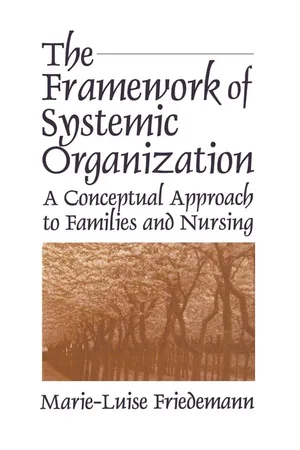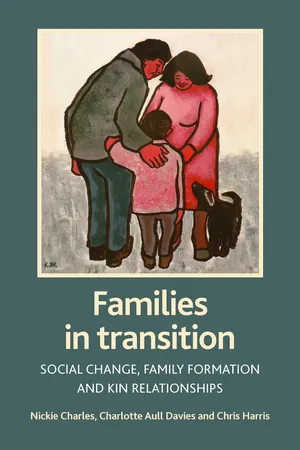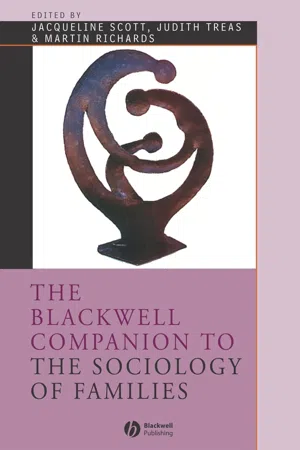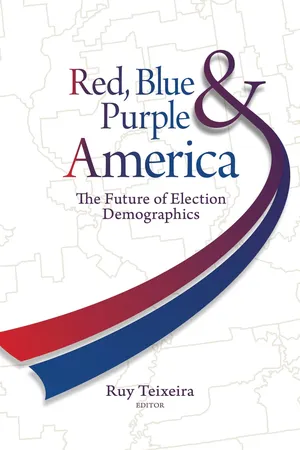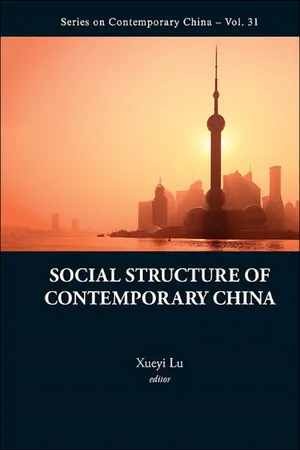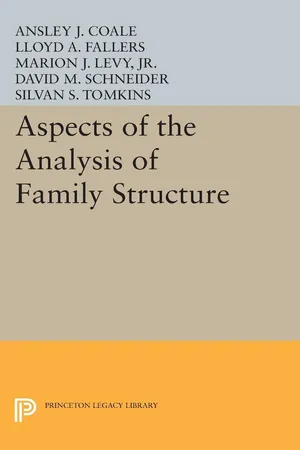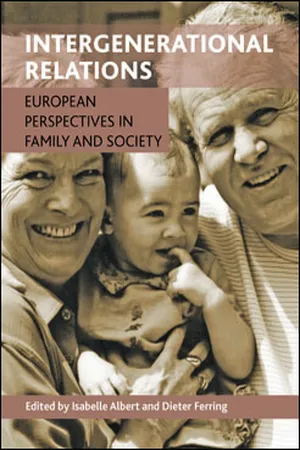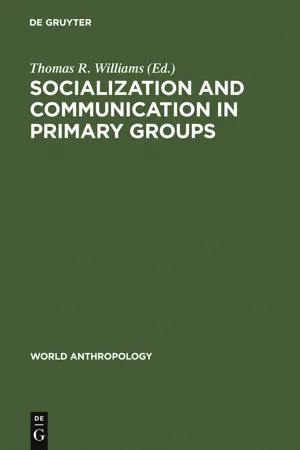Social Sciences
Changes in Family Structures
Changes in family structures refer to the shifts in the composition and organization of families over time. This can include changes in marriage patterns, divorce rates, cohabitation, and the prevalence of single-parent or blended families. These changes are influenced by various social, economic, and cultural factors, and have significant implications for individuals and society as a whole.
Written by Perlego with AI-assistance
Related key terms
1 of 5
12 Key excerpts on "Changes in Family Structures"
- eBook - PDF
- Liz Steel, Warren Kidd, Anne Brown(Authors)
- 2012(Publication Date)
- Bloomsbury Academic(Publisher)
Norms regarding family life may vary but there are common aspects that define a ‘family’ – a common residence, economic cooperation, adults in a sexual relationship, The Nature of Families and Households 11 reproduction. However, even in Murdock’s time, there were researchers who challenged the dominant view. Gough (1959) conducted an exhaustive study of the Nayar people of Kerala in Southern India, where Nayar women could take up to 12 ‘visiting husbands’ after completing the tali – ritual marriage to a suitable Nayar husband. This contradicts the functionalist view, as Gough’s research seems to point to an ‘exception’ in the universal nuclear family. Young and Willmott (1975), in the UK, were also finding evidence of the continued existence of the extended family in their research in the East End of London, corroborating other studies of deep sea fishermen’s families (Tunstall 1962) and coal miners (Dennis et al. 1956) where the existence of female-headed (matri-focal) extended families was also evident. A brief review of the impact of social change on the family The considerable social, economic and demographic changes that have taken place in soci-ety over the last 40 years or so have led to wide-ranging changes in family and household structure. These have led to changes in the foci of sociological study to incorporate and accommodate a much more complex and uncertain view of the nature of families and households. Later chapters will examine social change and sociological perspectives in more detail. Here, we will provide an overview of some of the most important aspects of the changes. One of the most significant changes is in the position of women. There has been a huge rise in the numbers of married women who work outside the home and there have been considerable changes in their expectations based on this change. Girls stay on at school longer and are now in the majority in higher education. - eBook - PDF
The Framework of Systemic Organization
A Conceptual Approach to Families and Nursing
- Marie-Luise Friedemann(Author)
- 1995(Publication Date)
- SAGE Publications, Inc(Publisher)
8 Crises With Change in Family Structure Three propositions that are of relevance here can be advanced by using the framework of systemic organization and the preceding discussions of family structure (Chapter 3) and crisis (Part 3, Introduction): (a) Family structure is a process (Minuchin, 1974) in that individuals, to the best of their ability, build those types of families that promise to safeguard them and allow them to best meet their developmental needs, (b) Being an attribute of process, structural changes are consid-ered normative transitions and occur in each family as it moves through time; as members are born or otherwise added to the house-hold, leave the family, or die; and as the family seeks congruence with its environment. In a rapidly changing environment, however, healthy families may be those whose trajectory of development encompasses structural changes beyond normative transitions (Staples, 1989). The existing diversity of environments requests a variety of family forms to interact with a multitude of environmental systems that are driven by sometimes incompatible ideologies, (c) If structural changes are attributes of family process, it follows that crises related to structural changes are also developmental crises for the individuals involved and are not distinguishable from the cases described in the preceding part. Because structure is fluent, nurses need to deemphasize it as a 136 137 Crises With Change in Family Structure distinguishing variable and instead focus on the overall family life process. Of specific importance in evaluating family health and the need for nursing care are the target of growth and the process of system change. Structural transitions can be categorized in various ways. Although some are desirable or pleasant, others, even normative transitions, are unpleasant and may present difficult challenges with a potential for crises. One such example is widowhood accompanied by severe feel-ings of loss and grief. - eBook - PDF
Families in transition
Social change, family formation and kin relationships
- Charles, Nickie, Davies, Charlotte, Nickie Charles, Charlotte Davies(Authors)
- 2008(Publication Date)
- Policy Press(Publisher)
In the ‘noughties’, in contrast, the relationship between families and social change is understood in different terms, most of which take the 1960s as marking a major social transition. This transition is variously conceptualised as the shift from modernity to post-modernity, reflexive modernity, late modernity or risk society, from industrial to post-industrial society, and from patriarchal to a less patriarchal society. Associated with fundamental structural change are cultural changes involving, inter alia, a move from material to post-material values. Concepts such as globalisation, individualisation, detraditionalisation and reflexivity have all been used to try and capture these social changes and to describe the type of society in which we are now Families in transition 2 living. They have also been influential in research on families. Thus, what is happening to families is often understood in terms of increasing individualisation and detraditionalisation. These concepts are used to explain changes in the social networks within which families exist (and which are partly constituted by kin) and in the moral values underpinning family life. Conceptualisations of social change therefore have implications for how we understand family lives. It is because of this that in this first chapter we investigate different ways of theorising social change, exploring particularly how changing gender relations and patterns of family formation are seen as a fundamental aspect of social change. In so doing we develop a critique of these conceptualisations which is both theoretical and based on empirical research on families and kinship. In Chapter 2 we explore the structural and cultural changes that have taken place since 1960 and which these theories attempt to explain. - eBook - PDF
Sociology
The Essentials
- Margaret L. Andersen; Howard F. Taylor, Margaret Andersen, Howard Taylor(Authors)
- 2016(Publication Date)
- Cengage Learning EMEA(Publisher)
All Rights Reserved. May not be copied, scanned, or duplicated, in whole or in part. Due to electronic rights, some third party content may be suppressed from the eBook and/or eChapter(s). Editorial review has deemed that any suppressed content does not materially affect the overall learning experience. Cengage Learning reserves the right to remove additional content at any time if subsequent rights restrictions require it. are long-term changes in the social structure of society, such as women’s increased work roles and accompanying changes in men’s roles; population changes (such as aging and immigration); and even things like the increased reliance on technology, which can alter communication patterns in families. → THINKING Sociologically What are some of the popular television shows about fam-ily life? Spend some time systematically observing one or more of these shows. What do they communicate about the family ideal ? Are the images consistent with the actual data on families shown in this chapter? 100 90 80 70 60 50 40 30 20 10 0 1980 14.6 16.5 17.6 18.8 2.9 4.4 5.6 7.1 40.6 41.9 37.1 35.1 34.1 42.0 41.7 40.0 1990 2000 2010 Percent Married, with children Married, no children Male-headed households Female-headed households ▲ Figure 13.1 The Changing Character of U.S. Families, 1980–2010 Over the thirty-year period from 1980 to 2010, the composition of U.S. families has changed considerably. What are the major changes that you can iden-tify from this figure? What sociological factors do you think help explain this change and, similarly, what other changes in society do such changes in the composition of families then create? Data: U.S. Census Bureau. 2013. The 2012 Statistical Abstract . Washington, DC: U.S. Department of Commerce. www.census.gov Family diversity is the norm in American society, with no one type of family shaping people’s experience. - Jacqueline Scott, Judith Treas, Martin Richards, Jacqueline Scott, Judith Treas, Martin Richards(Authors)
- 2008(Publication Date)
- Wiley-Blackwell(Publisher)
There is no doubting the message that large-scale, meta-analytic research gives us. On average, separation, divorce, and stepfamily living put individuals at risk in comparison with those who stay in ‘‘intact’’ family households. Those risks are sufficiently large that we should not ignore them. Household structure and separ-ation in themselves, however, explain a small amount of variance in outcomes for both adults and children. More significant are the processes, diverse experiences, and the meanings of these for family members. Gillis has distinguished the families we live with from the families we live by. The first are the day-to-day realities for children and their parents, and often differ from the scripts provided for families by their communities and cultures. Morgan (1996) suggests that family is properly regarded as a verb; we ‘‘do’’ family as a set of social practices, rather than being children, families, and divorce 335 family in a static sense. By considering families in this way, we can begin to identify what leads to optimal adaptation and enhances the likelihood of stability for family groups, without resorting to structure as the default independent variable. Not only are diverse household structures in all probability here to stay; it is also true that many work very well in nurturing the well-being and development of their members. Our task, then, is to understand those aspects of families that, regard-less of structure, promote resilience and adaptability. This means, for example, taking a stronger focus on processes in families, and on meanings of transitions for individuals. Change, and multiple change, is a different issue. The clear message from research is that chronic instability and multiple transitions put children at significantly increased risk.- eBook - PDF
Red, Blue, and Purple America
The Future of Election Demographics
- Ruy A. Teixeira(Author)
- 2009(Publication Date)
- Brookings Institution Press(Publisher)
Family, Religion, and Generational Change 147 O ver the last three decades the American family has been undergoing a pro-found and far-reaching transformation. Both family structure and family values have been changing and, as a result of these changes, the American family is a much-altered institution. As the core institution of society, the family affects all other aspects of society. This is especially true of politics. Political leanings are notably influenced by both family structure and family values. Moreover, the relationship is dynamic, with the connection between the family and politics changing over the last generation. First, this chapter traces these developments and examines how household and family composition, family roles, and attitudes and beliefs about the fam-ily have changed. Second, it examines how family structure and family values relate to political leanings (presidential voting, party identification, and polit-ical ideology). Finally, it considers what the future prospects are for the polit-ical impact of family structure and values. 1 Overall Trends Affecting overall trends are both the structural changes in marriage, in child-bearing and child rearing, and in labor-force participation and the changes in attitudes and values. five Changes in Family Structure, Family Values, and Politics, 1972–2006 T OM W. S MITH Marriage Although it is still a central institution in American society, marriage plays a less dominant role than it once did: the proportion of adults who have never been married rose from 15 percent in 1972 to 24 percent in 2006 (see appen-dix, table 5A-1). When the divorced, separated, and widowed are added in, 75 percent of adults were married in the early 1970s, but by the 2000s only 56 percent were. The decline in marriage comes from four main sources. First, people are delaying marriage. Between 1960 and 2003 the median age at first marriage rose from 22.8 to 27.1 years for men and from 20.3 to 25.3 years for women. - eBook - PDF
Seeing Sociology
An Introduction
- Joan Ferrante(Author)
- 2015(Publication Date)
- Cengage Learning EMEA(Publisher)
401 Does it matter who is holding this five-year-old boy’s hands? If the adults holding this boy’s hands were his two dads, would it change how you see the boy and his life? What if the adults were two uncles, or just two people in the community? What if one or both of the adults happened to be a woman? No matter who is holding this boy’s hands, it is obvious that there is a strong bond and emotional tie among the three that is unaffected by any departure from what we define as the norm. Sociologists consider the family a social institution that binds people together through blood, marriage, law, and/or social norms. When sociologists study family, they do not have a particular family structure in mind as an ideal. Instead, they consider the social forces that affect the ever-changing structure of families. Those social forces include, but are not limited to, life expectancy, women’s ability to control pregnancy, and employment opportunities for males and females. Families DEFINING FAMILY 401 11.1 Defining Family 11.2 Family Structure in Three Countries 11.3 Economy and Family Structure 11.4 Social Forces and the Changing Family 11.5 Intergenerational Family Relationships 11.6 Caregiving 11.7 Applying Theory: Changing Family Forms Summary Putting It All Together Copyright 2016 Cengage Learning. All Rights Reserved. May not be copied, scanned, or duplicated, in whole or in part. Due to electronic rights, some third party content may be suppressed from the eBook and/or eChapter(s). Editorial review has deemed that any suppressed content does not materially affect the overall learning experience. Cengage Learning reserves the right to remove additional content at any time if subsequent rights restrictions require it. 402 SEEING SOCIOLOGY Defining Family You will learn about the challenges of defining family and what being part of a family means. - Pamela Balls Organista, Gerardo Marin, Kevin M. Chun(Authors)
- 2009(Publication Date)
- SAGE Publications, Inc(Publisher)
Families can likewise change or alter their environments to enhance their development and adaptation to new cultural settings. The ability of families of color to meet their daily needs and negotiate normative life transitions is complicated by the added stressors of discrimination and prejudice. Therefore, the diverse life experiences of ethnic minority families can only be fully appreciated by exploring the cultural, socioeconomic, and historical contexts in which they unfold. HOW DO YOU DEFINE A FAMILY? FACTORS AFFECTING FAMILY STRUCTURES AND HOUSEHOLD ARRANGEMENTS This appears to be a simple question until you consider all of the different family constellations that are seen in American society today. The “nuclear family”—a family consisting of a father, mother, and their children—was con-sidered the standard unit of American family life in much social science research published in the last century. However, shifting sociopolitical atti-tudes toward gender roles and marriage, and significantly higher divorce rates in the United States, have pushed for broader definitions of the family since that time. Historical assumptions about nuclear family functioning have also Family Structure, Relations, and Socialization – – 191 been called into question. Research with families from across the world indi-cates that nuclear families do not necessarily function in isolation from extended kin and are not universally individualistic as once proposed (Georgas et al., 2001). Furthermore, the nuclear family unit does not fully capture how ethnic minority families organize and sustain themselves. In addition to nuclear family households, ethnic minority families maintain multigenerational house-holds, single-parent households, and households that are headed by grandpar-ents or other family relatives. In some ethnic minority communities, these types of households are more “normative” than the nuclear family household and form the foundation for healthy family functioning.- eBook - ePub
- Xueyi Lu(Author)
- 2012(Publication Date)
- WSPC(Publisher)
From the modernization process, we can see that the higher the level of industrialization and modernization, the more apparent the miniaturization tendency of families becomes. From changes in China’s current family structure, especially changes in the family structure in major cities, we can observe a similar trend. Thus, it can be expected that the miniaturization and diversification of Chinese families will continue. Future Chinese family structures will experience the following changes: the nuclear family will keep its position as a main form of family structure; the stem family will continue to exist; the number of mobile and drifting families, intergenerational families and separated families will tend to reduce gradually along with urbanization; empty nesters and single-parent families will occupy a considerable proportion and develop slowly; the portion of DINK families will grow slowly; joint families will disappear gradually; non-marital family forms will become more complex and the number will be larger, possibly involving youth trial marriage, extra-marital cohabitation among the middle-aged, widowed elderly persons living together and homosexual cohabitation.3.2.Policy Recommendations in Response to Changes in Family Structure
Based on the analysis of the changes in family structure, we can see that family structure and social structure are very closely related; family structure is a reflection of the changing social structure and at the same time has an important impact on the reconstruction of the social structure. Thus, in order for the family structure to better suit the modern social structure, we make the following suggestions according to the social development trends and in response to the problems brought about by the change in family structure.3.2.1.Give Full Play to the Pension Function of Family, Community and Society to Cope with the Old-Age Care Challenge of Empty-Nest Families
In the current situation of China, neither the family, government nor society as a whole can take on the task of old-age care alone. Thus, a tripartite effort is needed to deal with the pension problem. In major cities with developed economies and abundant social resources, we should actively explore a joint pension system combining the family and social pensions. Communities should integrate existing resources to enhance service functions for the elderly. Families can adopt a combined family (young couple and the two pairs of parents live separately but in close proximity and take care of each other while having personal interactions in their daily lives) or a wavering family model (young couples shuffle between homes of the two pairs of parents and have their own bedrooms at both houses or have their own separate residences) to enhance parentchild inter-generational exchanges, thereby strengthening the family’s pension function. In rural areas, especially in remote rural areas, elderly care may explore a village-community-based pension model, capitalizing on villages’ advantages in terms of cultural background, family contact and community supervision function, among others. Other options include the integration of the one-child family elderly subsidy system, the existing rural poverty relief, the “five guarantees” system and the rural cooperative medical care system as well as other resources in order to establish a standard and sustainable old-age security system. In addition, we need to strengthen the construction of the social welfare pension agency, ensuring that elderly people who need institutional care can be taken care of properly. This is not just a useful supplement to the family and social endowment insufficiency; it also reflects the degree of a society’s development. - eBook - PDF
- Ansley Johnson Coale, L. A. Fallers, Philip Burke King(Authors)
- 2017(Publication Date)
- Princeton University Press(Publisher)
Aspects of the Analysis of Family Structure as such, but little of it has been aimed at very general levels. In recent years, especially, no other literature in sociology testifies more strongly to the preoccupa- tion of a great number of sociologists with an ex- tremely limited and special range of all the social materials of world history. Even apparently general- ized treatments are likely to be narrowly focused on such specific cases as the modern American family. If the focus is more general, it rarely extends the treatment further than the limit of the type of family associated with relatively modernized societies. Ac- tual references to more general levels are rare. The appearance of greater generality is largely a function of supplementary ad hoc remarks about other cases or by confusion of the specific case studied with the more general. 2 There are good reasons to suggest that these con- cepts and their associated phenomena should occupy a more central role in our search for general systems of analysis and general theory. Before going into these matters, however, I should like to define the terms "kinship structure" and "family" as I shall use them. Kinship structure is defined as "that portion of the analytic and concrete structures of a society in terms of which, in addition to other orientations sometimes equally if not even more important, the membership of the units and the nature of the soli- darity among the members of the units is determined by orientation to the facts of biological relatedness and/or sexual intercouse." 3 A family unit is defined 2 See, for example, T. Parsons and R. F. Bales, Family, Socialization and Interaction Process, Free Press, Glencoe, 1955· 3 Taken with slight modification from The Structure of Society, Princeton University Press, Princeton, 1952, p. 203. All concepts of structure and function, institutions, etc., as 2 - eBook - PDF
Intergenerational Relations
European Perspectives in Family and Society
- Albert, Isabelle, Ferring, Dieter(Authors)
- 2013(Publication Date)
- Policy Press(Publisher)
In spite of continuing economic differences and severe poverty in some regions of the world, in most regions changes in direction of greater affluence, higher levels of education and higher life expectancy (summarised in the Human Development Index (HDI); UNDP, 2011) have been observed. Debate is going on whether economic globalisation will eventually lead to a general cultural homogenisation or whether longstanding cultural traditions (for example, religions) have an impact on the ways societies manage their paths through modernisation, as recent theoretical approaches argue (Berger and Huntington, 2002; Inglehart and Oyserman, 2004). 168 Intergenerational relations The way in which families function and intergenerational relationships are negotiated in a society is an important aspect of that society’s culture.The family as the main socialisation agent is responsible for the transmission of cultural values and practices and its functioning is at the same time affected by the larger cultural context (Bronfenbrenner, 1979;Trommsdorff, 2009). Early family modernisation theorists believed that the Western nuclear family with its high importance of the spousal relationship and its de-emphasising of contact with the extended kin group is the prototype of a modern family that will eventually emerge in all societies (Goode, 1963). This development is reflected in an increased emphasis on individual freedom, autonomy and self-expression, and a declining importance of traditional orientations, authority and individual dependencies (Inglehart and Welzel, 2005). Declining interpersonal and familial bonds may in turn bear the risk of increasing isolation and interpersonal alienation in a society (for example, Bellah et al, 1985). Kagitcibasi’s Family change theory Family change theory (FCT) (Kagitcibasi, 1996, 2007) presents an alternative to these classical modernisation theoretical assumptions with regard to the family. - Thomas R. Williams(Author)
- 2011(Publication Date)
- De Gruyter Mouton(Publisher)
Structural Changes in the Family in Kerala, India GEORGE KURIAN INTRODUCTION A number of sociologists have argued that the nuclear family is going to be the dominant type of family structure in the modern world because it is more suitable to the modern, urban, industrial society (Goode 1963; Parsons 1961). However, there is another point of view one should take into consideration, which takes into account variable types of change depending on the needs of a particular society, the social utility of a particular society, and the social utility of a particular type of family system. From a residential point of view, the physical size of the extended family shows a definite decrease though the close kin and social network are maintained. The observations are made by Kolenda (1968: 340-341): First, a large number of variables placeable under the rubrics of industrialization, urbanization, and westernization do seem to relate to, or at least to correlate with, a trend toward increasing proportions of nuclear families and decreasing proportions of joint families. In India, factors that appear to be related to this trend are western secular education, modern salaried occupations, development of market cash economies displacing agrarian subsistence economies. ... Second, industrialization, modernization, and westernization in their various manifestations may serve to strengthen the joint family because an economic base has been provided to support a joint family or because more hands are needed in a new family enterprise or because kin can help one another in the striving for upward mobility. The author wishes to express his grateful thanks to the generous grant of The Canada Council in 1971-1972 for field work in Kerala, India. 60 GEORGE KURIAN In Kerala, according to evidence the author gathered from a study made in 1972 among 250 families representing all the major religious and caste groups and all regions of Kerala State, the kinship ties are still fairly strong.
Index pages curate the most relevant extracts from our library of academic textbooks. They’ve been created using an in-house natural language model (NLM), each adding context and meaning to key research topics.

